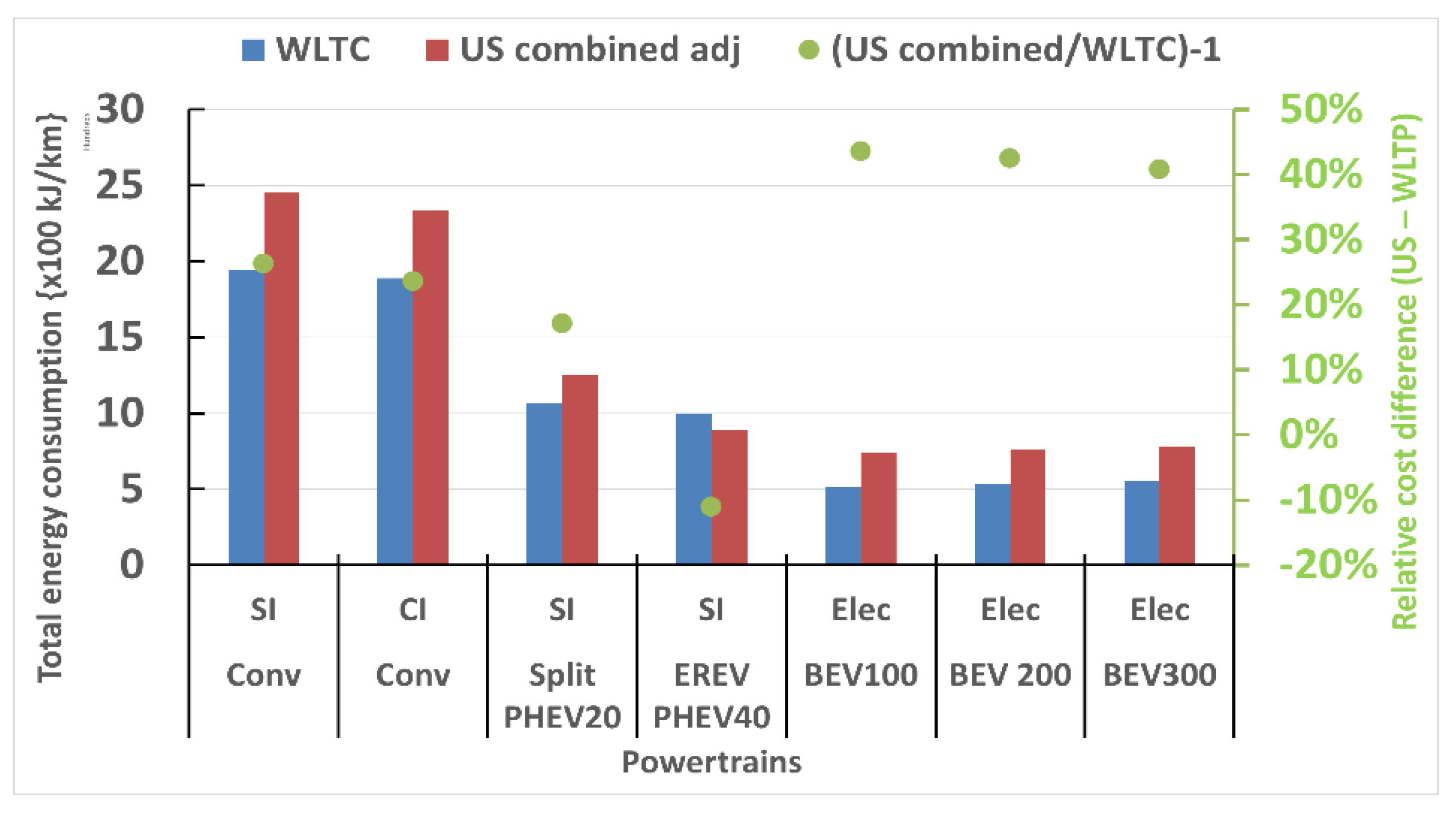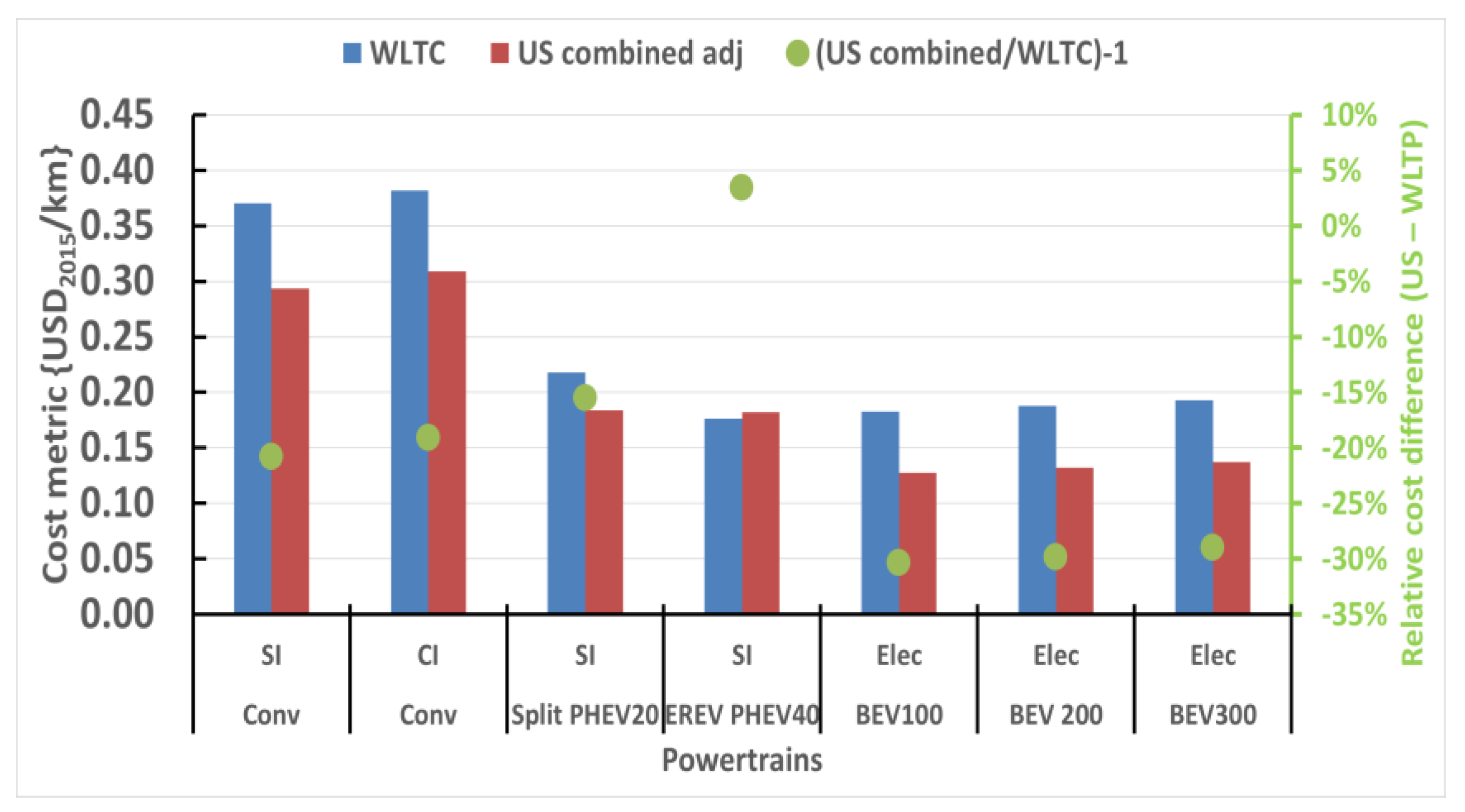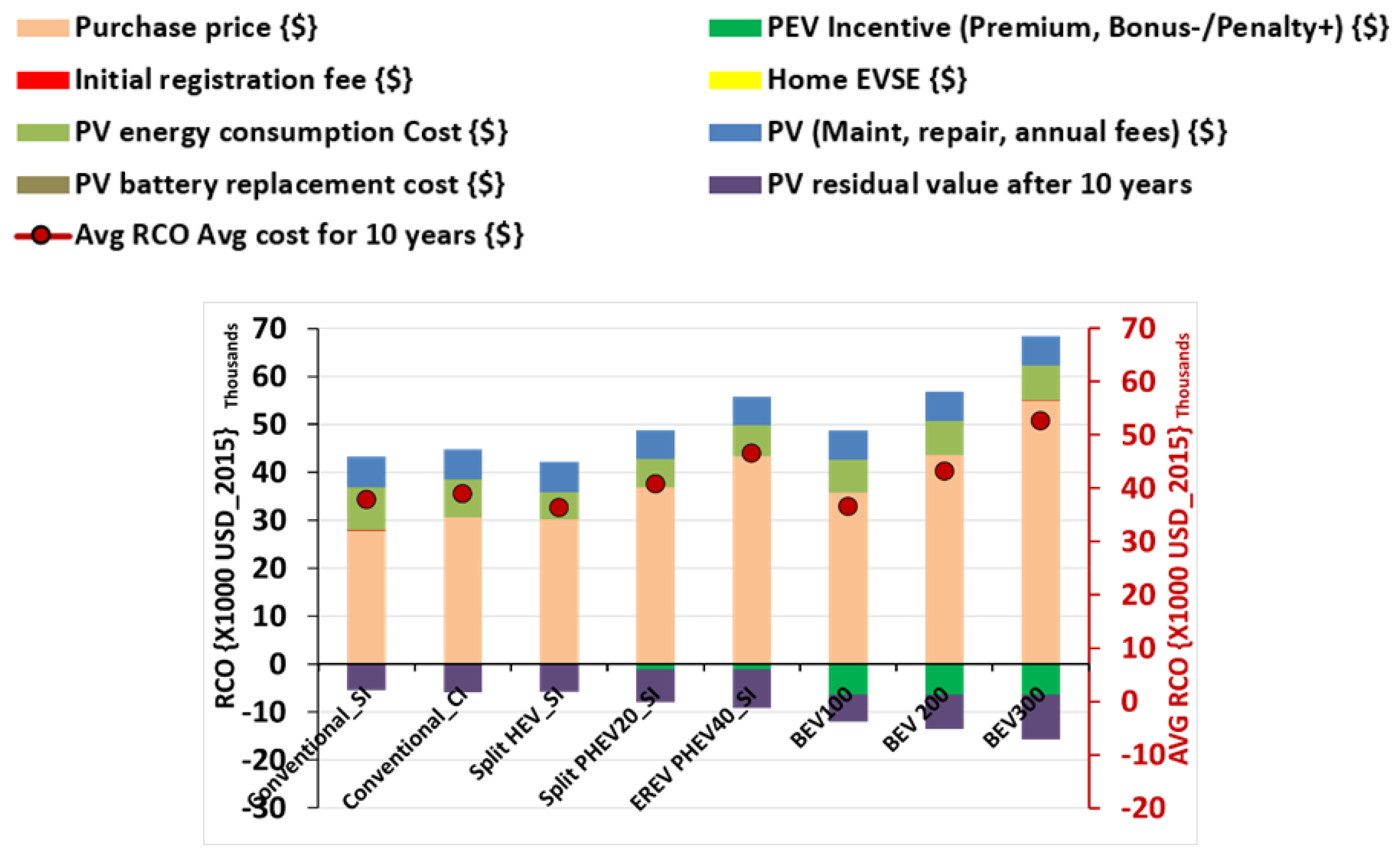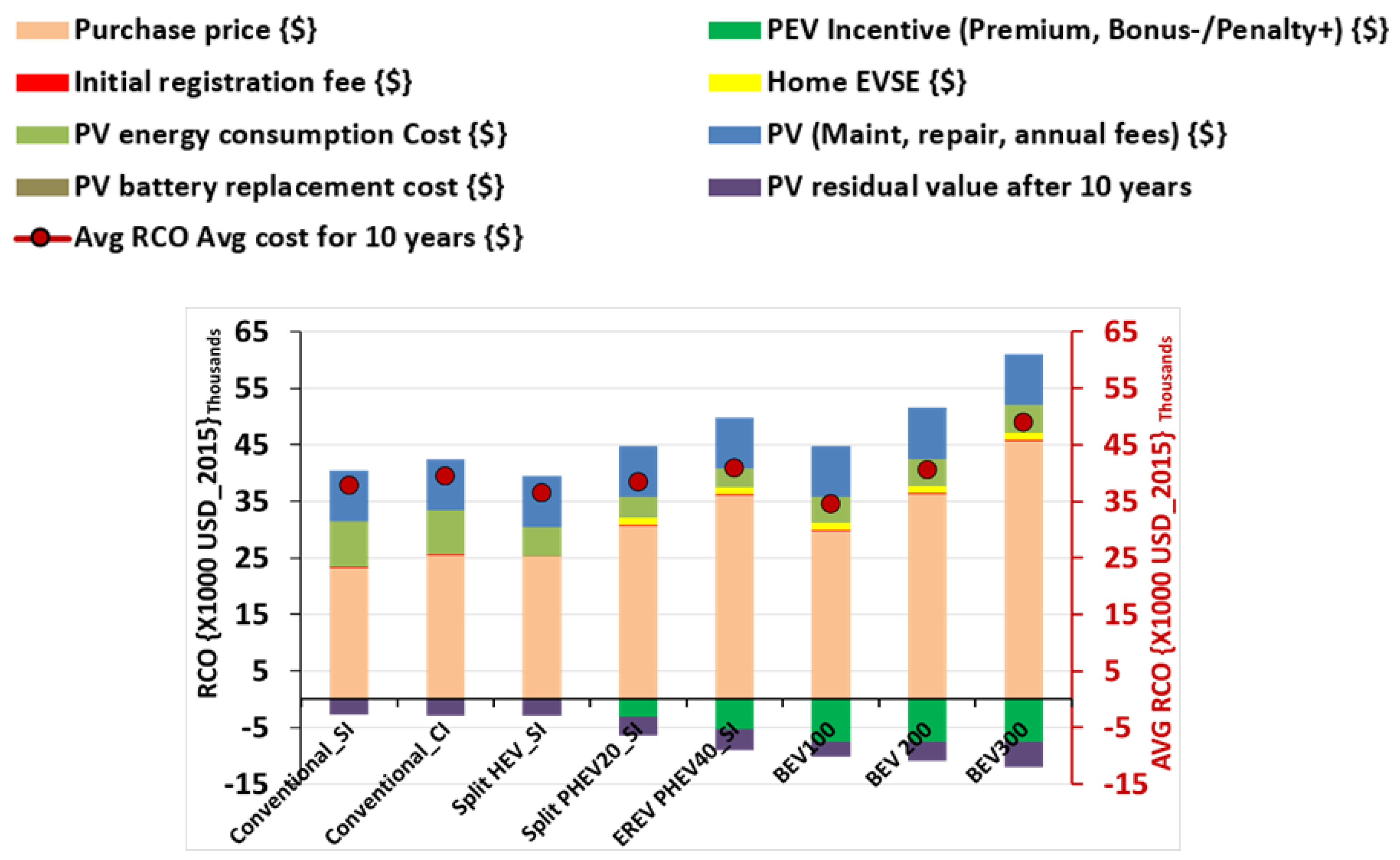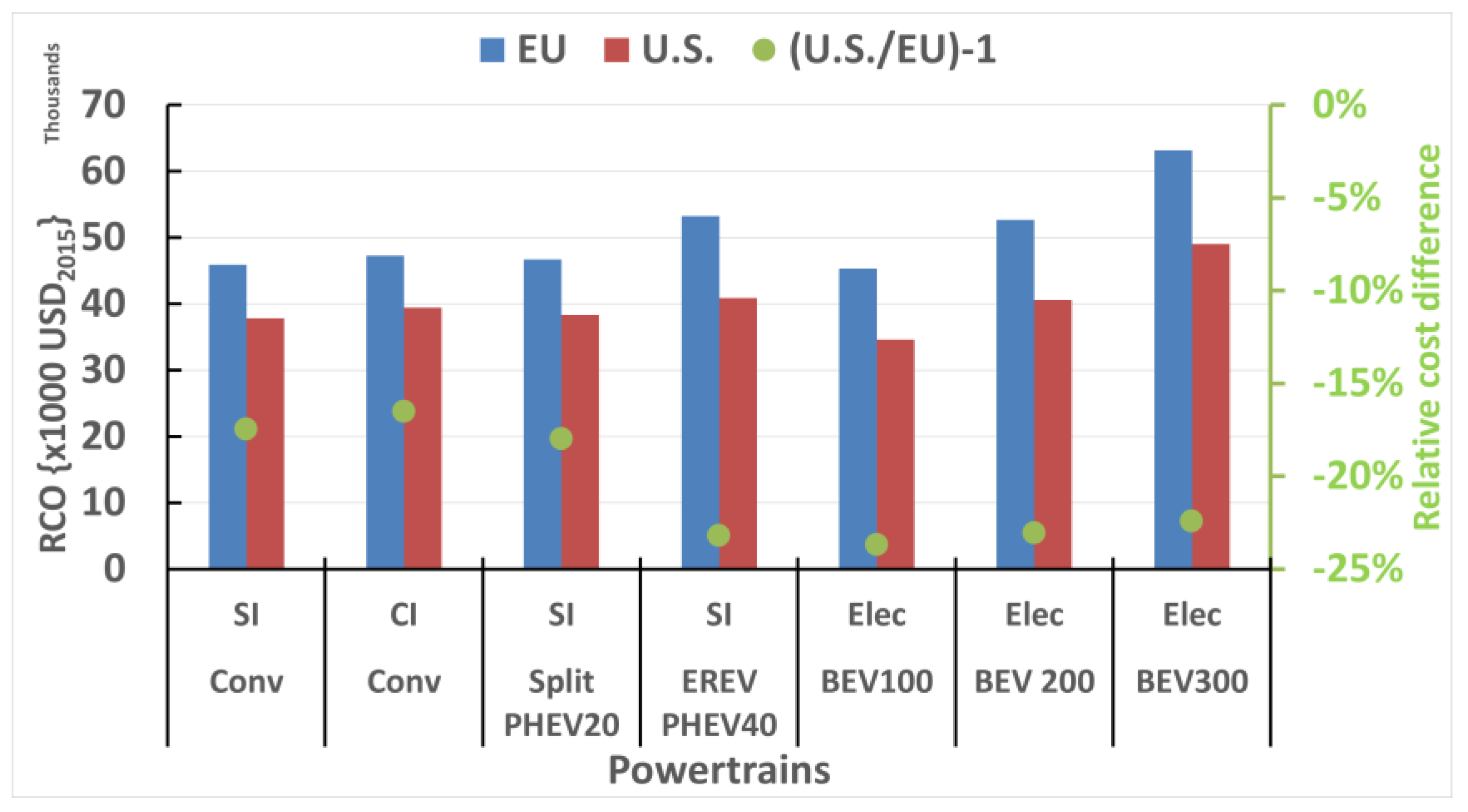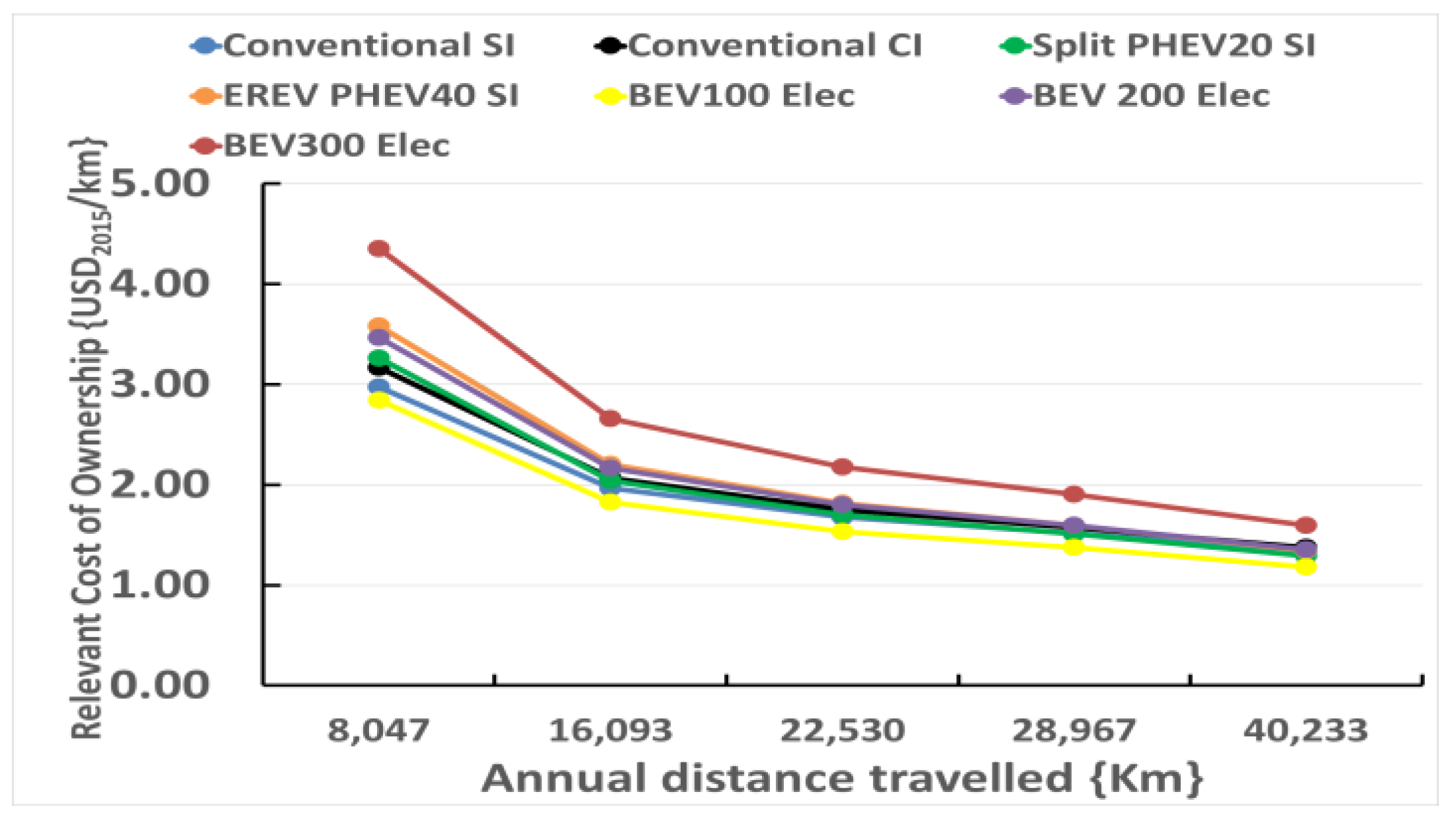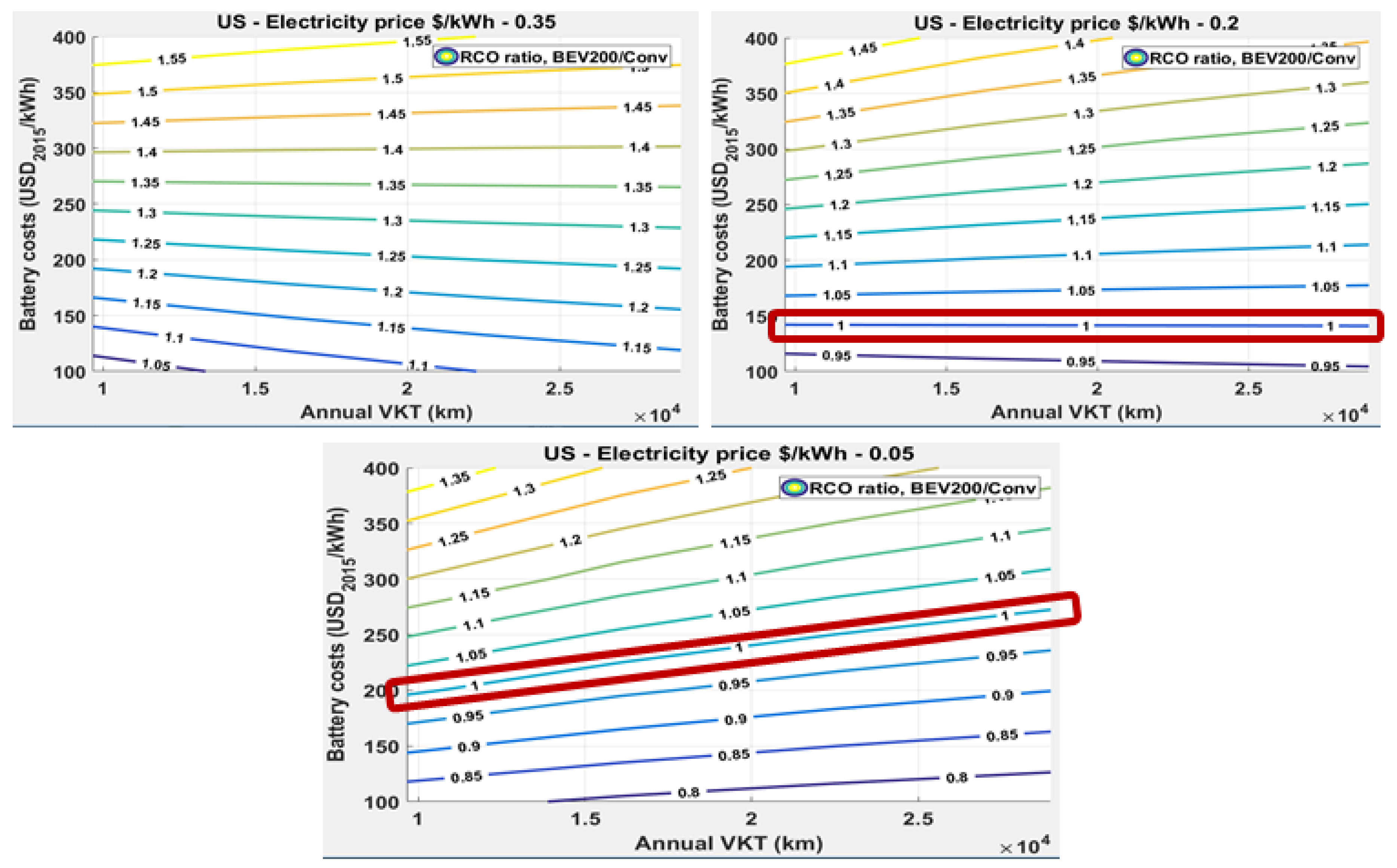2.1. Vehicle Attributes
To evaluate the fuel efficiency benefits of advanced vehicles, each vehicle was simulated using Autonomie [
7]. Each vehicle is sized to meet the same vehicle technical specifications such as performance and grade-ability [
8].
The energy efficiency was then estimated for the different vehicles over the Worldwide harmonized Light vehicles Test Cycle (WLTC) and the U.S. combined cycle. Conventional and plug-in midsize vehicles were simulated through six different timeframes (2020–2050) for gasoline and diesel fuels. The attributes of future vehicles were taken from Moawad et al. [
8]. We focus in this paper only on four different powertrains (conventional; split PHEV (PHEV20); EREV (PHEV40); and battery electric vehicles (BEV100, BEV200 and BEV300)). The split PHEV was modelled with one electric motor and a power-split design, and the EREV was modelled with two electric motors and a powertrain similar to the Voltec design [
9].
We assumed technology advancement based on the U.S. Department of Energy (DOE) Vehicle Technology Office research and development goals. Further details on the simulations can be found in Moawad et al. [
8].
The above vehicles were simulated in Autonomie under the Worldwide harmonized Light vehicles Test Procedure (WLTP), U.S. Urban Dynamometer Driving Schedule (UDDS), and U.S. Highway Fuel Economy test (HWFET) drive cycles, using the same road load coefficients for all cycles. Adjustments were applied to the UDDS and HWEFT drive cycle fuel consumption values in accordance with the U.S. current fuel economy label procedures [
4].
To estimate the UF (the fraction of distance driven in CD mode), the daily driving distance was assumed to follow a gamma distribution, which was found to fit detailed driving records from Seattle by Lin et al. [
10]. A mean of 61.8 km/day and a mode of 20.6 km/day were assumed for U.S. drivers, based on an analysis of the U.S. 2009 National Household Travel Survey by Krumm [
11]. This distribution gave a dependence of UF on the PHEV CD range that approximated the CD range dependence used in the standard practice recommended by SAE International for PHEVs that are charged once per day [
12]. This distribution may not be accurate for other populations [
13], but it captures the qualitative shape of realistic driving distributions and provides a convenient way to approximate how PHEV UF depends on daily average driving distance [
14]. The mean distance was varied to account for different annual driving distances, and the mode was assumed to vary in proportion to the mean. A constant value of 300 driving days per year was assumed. PHEV drivers were assumed to charge once per day.
We estimated the ownership costs under different assumptions to represent U.S. and German consumers. Combinations of the following parameters were evaluated that make PEVs cost-competitive with competing (conventionally powered) vehicles:
The fuel and electricity consumption as estimated by WLTP and U.S. adjusted drive cycles,
The future vehicle prices, estimated for year 2025,
A range of potential future battery cost estimates,
The fuel prices (reflecting ranges of possible prices in the U.S. and Germany),
The annual driving distance (ranges representative of U.S. and German drivers).
2.2. Cost Calculations
The vehicle costs are calculated from the characteristics of the components (power, energy, weight, etc.) [
8]. Both the vehicle and fuel cost, based on the energy efficiency values, are then used to calculate ownership cost. Maintenance costs for year 2025 were assumed to be 0.05 (U.S. 2015 dollars per kilometer (USD 2015/km) for all powertrain types. This value was in the middle of the range suggested by Rousseau et al. [
3].
The assumptions shown in
Table 1 are used to represent the near-term (year 2025) average prices of energy in Europe (Germany) and the United States and were assumed to be constant in future years. Constant electricity prices were assumed, neglecting alternative rate structures such as time-of-use, tiered rates, or special rates for PEVs.
Energy prices and average annual distance driven in the United States were based on the U.S. Energy Information Agency’s Annual Energy Outlook (AEO) for 2017 reference case. Energy prices for Germany were estimated for the year 2025 based on the projected price of crude oil (Brent Spot price of 85.03 USD 2015/barrel). High and low energy prices were based on AEO 2017 High Oil Price and Low Oil Price cases. Annual distance driven in new light duty vehicles (LDVs) by U.S. drivers was taken from AEO 2016 reference case. The mileage for German drivers is taken from the latest national transport survey [
15].
Cost models were used to estimate manufacturing costs for major vehicle components and subassemblies, which were then summed to give the total manufacturing cost of each vehicle in year 2025 [
8]. These manufacturing cost estimates were assumed to be the same for both American and European automakers (
Table 2). Cost model parameters were assigned values based on input from U.S. DOE vehicle technology managers and industry experts who provided a range of values from highly optimistic (high case) to pessimistic (low case).
The RCO was calculated from vehicle prices and other costs [
3]:
where
Investment costs include the vehicle manufacturing direct costs, manufacturer mark-up (accounted for by a retail price equivalent (RPE) factor), sales tax or value-added tax, both applied to the retail price, incentive (or bonus/malus premium/charge), and initial registration/licensing fees or taxes. For the BEV in the United States, the cost of home electric vehicle service equipment (EVSE) is also included in the investment cost. Given the capacity of BEVs, charging times using only a Level 1 charger do not meet the requirements of most consumers: a recent survey of California drivers found that only 12% of Nissan Leaf owners did not have Level 2 EVSE at home [
16]. Because of the higher voltage level (240 V) in Europe, EVSE costs are not considered for Germany.
Residual values after a service time of 10 years were calculated using regression equations developed by Pröpfe et al. [
17] for each powertrain type. These equations were developed from European vehicle sales data and may not accurately model resale values in the United States. Resale values are uncertain, particularly for PEVs, since the used PEV market is very immature. Residual values were estimated as a fraction of the total investment cost rather than purchase price, since the investment cost was assumed to approximate more closely the transaction cost as it includes incentives and fees, and since evidence suggests that incentives decrease residual values [
18]. A residual value of zero was assumed after a service time of twelve years or a total distance travelled higher than 338,000 km:
where
CInvest = Total investment (upfront) cost,
CManuf = Manufacturing cost,
FRPE = Retail price equivalent or mark-up factor = 1.5 [
19],
CIncentives = Feebate (bonus/penalties) or incentive, see
Table 3. Incentives are shown as positive if they decrease the cost and negative if they increase the cost;
CFee, init = Fees payable upon vehicle purchase see
Table 3,
TaxSales = State sales tax,
CBatt repl = Battery replacement (PHEV and BEV); we assumed no battery replacement in this paper,
CHome EVSE = Average cost of installing Level 2 EVSE [
20].
The incentives have a high impact on the RCO and are geographically dependent. In the United States, we considered only the federal subsidies (tax credits) for plug-ins, which depend on the battery total rated capacity in kWh as follows: 2500 U.S. dollars (USD) for each PEV with at least 5 kWh total battery capacity, plus 417 USD for each kWh in excess of 5 kWh, up to a maximum of 7500 USD. We treat these values as 2015 USD. In reality, the subsidy decreases for each automaker after the automaker sells more than 200,000 PEVs, which was neglected in this study. In Germany, the subsidies are 3000 euros (EUR) for each PHEV and 4000 EUR for each BEV [
21]. Using a conversion factor of one EUR to 1.0598 USD results in 3179 USD for each PHEV and 4239 USD for each BEV. These values are also treated as 2015 USD.
We evaluated sensitivities to assumptions by examining ranges of fuel prices, battery costs, and annual distance travelled. From these results, we examined which factors are most important in the United States and Germany for cost of ownership of PHEVs and BEVs, and under what combination of conditions PHEVs and BEVs are cost-competitive with other drivetrains.
